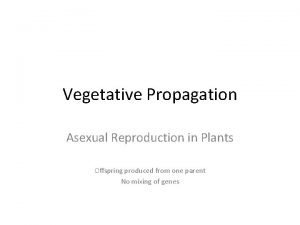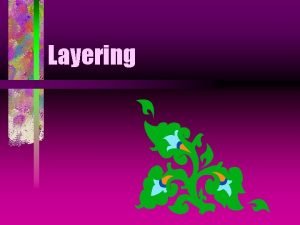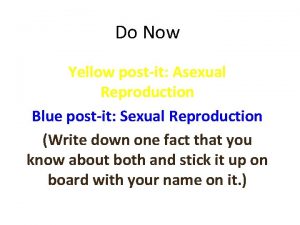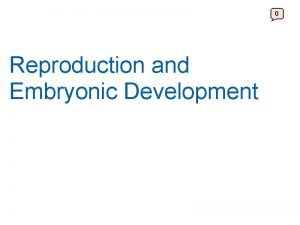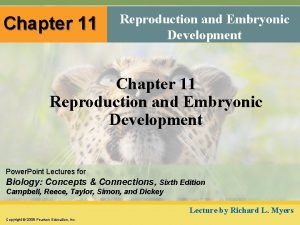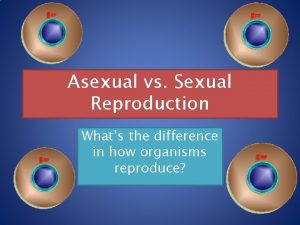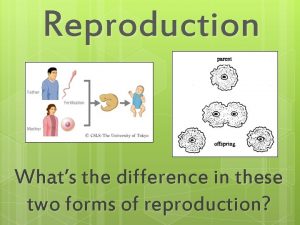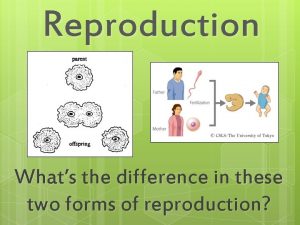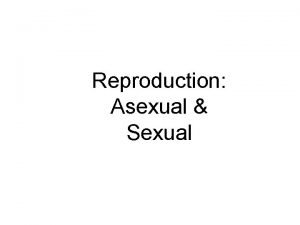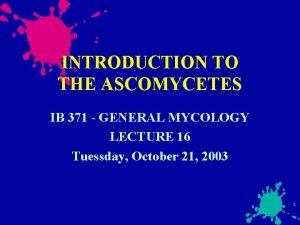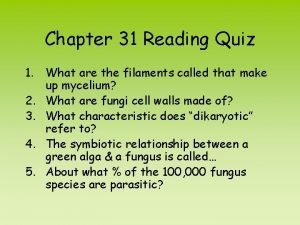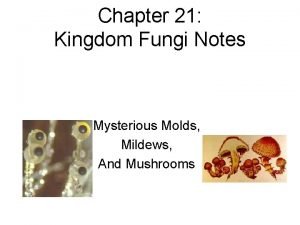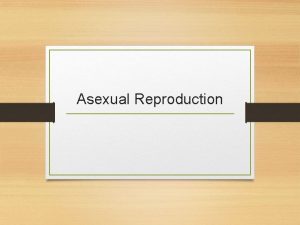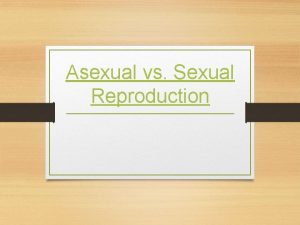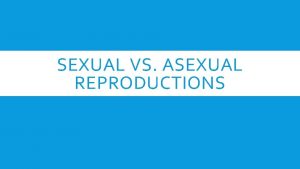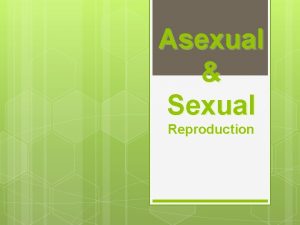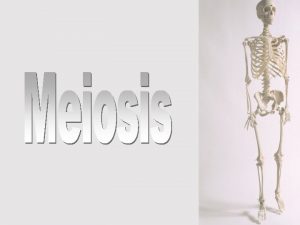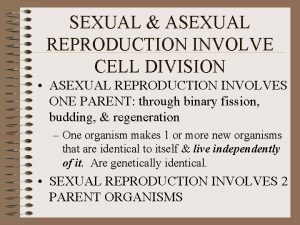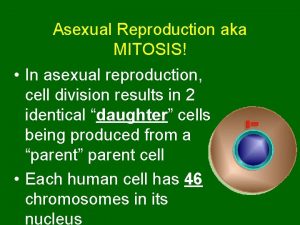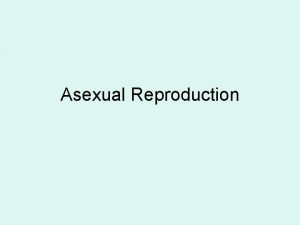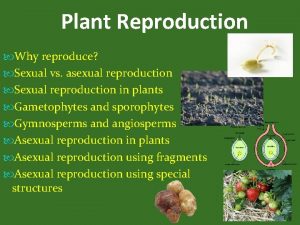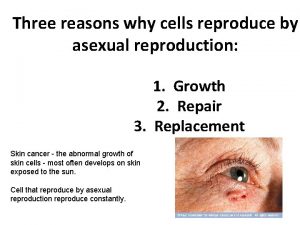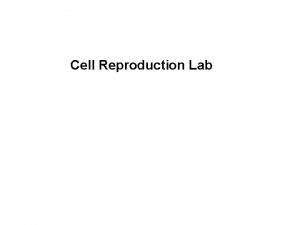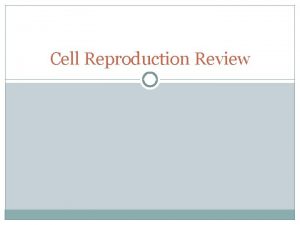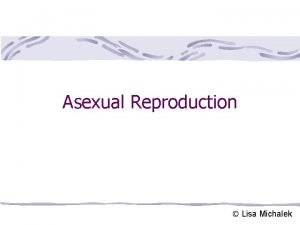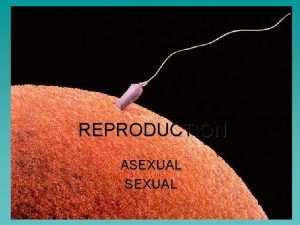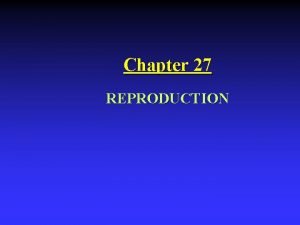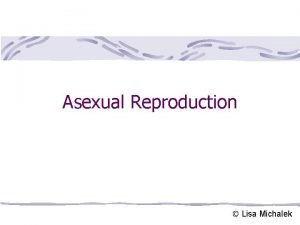Cell Reproduction Asexual reproduction the cells reproduce on


























- Slides: 26

Cell Reproduction

• Asexual reproduction: the cells reproduce on own, without contact with another. • Sexual reproduction: takes the genetics of two different individual to combine and form a new individual.

• DNA (deoxyribonucleic Acid) : is a long molecule that stores genetic info. It is a double helix of nucleotides. – The pairs are: Adenine with Thymine and Guanine with Cytosine * These are the genetic codes found in chromosomes.

• RNA (Ribonucleic Acid): is a single strand. – Instead of thymine, there is Uracil. • A-U • G-C – -copies code of DNA to direct protein sythesis.

• ATP (adenosine triphosphate) – Energy transfer molecule – Formed when cell respiration releases energy form food molecules. – Used for energy requiring processes.

Chromosomes • Are made up of a single DNA and proteins. Are coiled up in nucleus. • Each half of a chromosome is called a chromatid. – When divide, each new cell will get 1 chromatid from each parent. – Chromatids are held together in the middle by a Centromere.

• Sex Chromosome: determine the sex of the organism. X or Y. • Autosomes: all other chromosomes in the organism. – Human have 46 total chromosomes, or 23 pairs.

• Each cell has 2 copies of each autosome. You receive 1 copy from each parent. • The 2 copies are called Homologous Chromosomes. • Karyotype: a picture of the chromosomes.

• Diploid: have 2 sets of chromosomes (2 N) • Haploid: 1 set of chromosomes (1 N) – sex cells • Homologous Chromosomes: one of a pair of similar chromosomes. Each organism receives one copy from each parent. We have 22 pairs of homologous pairs, and one pair of sex cells.

Cell Divisions • 2 different ways of Cell Division – 1. Mitosis: which is for the body cells. Make new body and tissue cells. 1 cell will divide into 2 identical daughter cells with 46 chromosomes – 2. Meiosis: is the division of the sex cells. The cells divide in half, with only 23 chromosomes and form the Gametes (egg and sperm)



Mitosis • 1. Interphase: chromosomes make a copy

• 2. Prophase: chromatids still attached at centromere. Centrioles move to opposite poles and the spindle fiber start to appear.

• 3. Metaphase: chromtids line up in middle. Center attaches to spindle fibers, and divide.

• Anaphase: have 2 complete sets. The spindle fibers pull toward the poles.

• Telophase: DNA uncoils, membrane forms around chromosomes.

• Cytokinesis: cytoplasm divides, a new cell is formed.

Meiosis • Has 2 stages. The first stage is the same as mitosis. The cell copies and divides. The those cells just divide again, and end with ½ the chromomes. • Result on formation of egg and sperm


Meiosis I • 1. Prophase I: DNA coils up into chromosomes, spindle fibers appear, the chromosomes lime up next to its homologue called Synapsis. Each pair called a tetrad. The chromatids twist around allowing portion to break off and attach to adjacent chromatid, called Crossing-Over, which results in Genetic Recombination, a new mixture of genetic material.


• Metaphase I: tetrads line up in middle. Spindle fibers attach to centromere

• Anaphase I : each homologous chromosome move to opposite pole, then have a random separation. Independent Assortment.

• Telophase I: chromosomes reach opposite ends. • Now have 2 new cells with one chromosome from each homologous pair

Meiosis II • During Meiosis II, the DNA is not copied, the 2 cells go through the phases again and end in 4 cells , each has only ½ the original number of chromosomes.
 Binary fission in bacteria
Binary fission in bacteria Hare lynx
Hare lynx Venn diagram of asexual and sexual
Venn diagram of asexual and sexual Asexual reproduction cell division
Asexual reproduction cell division Nondisjunction in meiosis
Nondisjunction in meiosis Vegetative propagation
Vegetative propagation Types of asexual reproduction
Types of asexual reproduction Worms phylum
Worms phylum Parthenogenesis in mammals
Parthenogenesis in mammals Examples of animals reproduce asexually
Examples of animals reproduce asexually Layering asexual reproduction
Layering asexual reproduction Benefits of sexual propagation
Benefits of sexual propagation Asexual reproduction
Asexual reproduction Asexual reproduction
Asexual reproduction Whats asexual reproduction
Whats asexual reproduction Example of budding asexual reproduction
Example of budding asexual reproduction Chapter 19 asexual reproduction answer key
Chapter 19 asexual reproduction answer key Two types of reproduction
Two types of reproduction Whats sexual reproduction
Whats sexual reproduction Whats asexual reproduction
Whats asexual reproduction Asexual vs sexual reproduction
Asexual vs sexual reproduction Somatogamy in fungi
Somatogamy in fungi Asexual and sexual reproduction venn diagram
Asexual and sexual reproduction venn diagram Ascomycota asexual reproduction
Ascomycota asexual reproduction With name
With name Budding asexual reproduction
Budding asexual reproduction Venn diagram asexual and sexual reproduction
Venn diagram asexual and sexual reproduction





